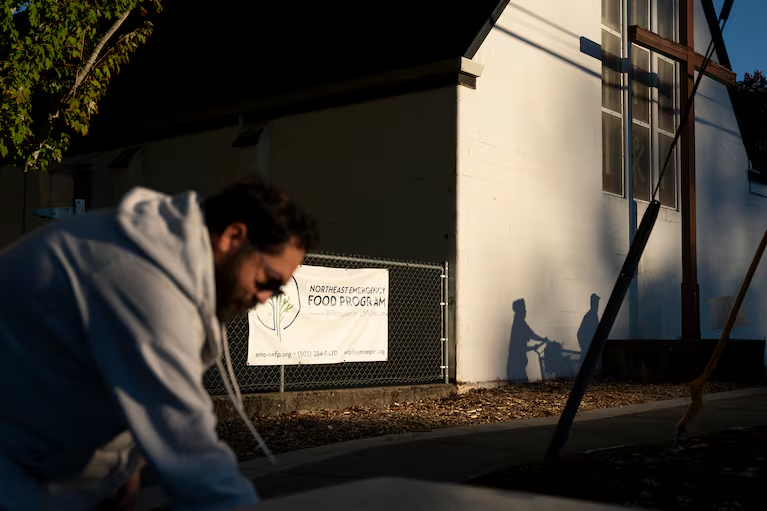Across Oregon, grocery prices continue to rise while food pantries struggle to keep shelves stocked. Now, a looming crisis threatens to deepen hunger across the state: hundreds of thousands of Oregonians could lose access to their food stamp benefits in November if the federal government shutdown continues.
More than 750,000 Oregonians rely on the Supplemental Nutrition Assistance Program (SNAP), also known as food stamps, according to Gov. Tina Kotek. More than half of those recipients are children, seniors, or people with disabilities. With Congress deadlocked over funding, benefits could run out at the end of October.
“I don’t know how I’m going to make ends meet,” said Nan Ahseln, who visited Portland’s Northeast Emergency Food Program on Tuesday. Volunteers loaded her cart with produce, bread, and canned goods — supplies she depends on as grocery bills rise faster than her income.
Also Read
Food Banks Brace for a Surge
The Ecumenical Ministries of Oregon’s Northeast Emergency Food Program, which typically serves 3,500 visitors a week, is already feeling the strain. On Tuesday morning, lines formed half an hour before opening. Inside the converted church basement, salsa music played as volunteers offered dried beans, frozen meat, and fresh vegetables.
“We’re expecting numbers to go through the roof,” said Ryan Sherman, a coordinator at the pantry. “This shutdown will push people here who have never needed us before.”
For families like Kodi Frasier’s, a Portland mother of two, the potential loss of SNAP benefits is devastating. “Our benefits cover about half of what we eat each month,” she said. “I already go to food pantries maybe once or twice a week. Last week, I went five times.”
In Central Oregon, more than 23,000 households rely on SNAP. Local anti-poverty group NeighborImpact is reaching out to churches and schools to prepare emergency meal programs and fill children’s backpacks with nonperishable foods. “It’s not like you can just eat grass,” said Scott Cooper, the organization’s director. “There’s no substitute for food.”
In Josephine County, where one in five residents receives SNAP, food banks are scrambling. “We’re shoring up as much as we can, but our network is already stressed,” said Josephine Sze, director of the county food bank. “It’s scary because we’re operating at a deficit.”
Ripple Effects on Oregon’s Economy
Beyond hunger, the SNAP freeze could ripple across Oregon’s economy. According to the Oregon State Treasury, every $1 spent on SNAP generates between $1.50 and $1.80 in local economic activity. If benefits stop, grocery sales could fall sharply, especially at small neighborhood stores.
“Once retailers start cutting orders because SNAP spending disappears, that loss multiplies,” said Michael Kuhn, an economist at the University of Oregon. “It affects jobs, supply chains, and local economies.”
Large retailers like Walmart and Safeway would see a hit, but smaller stores could suffer most. “They’ll reduce orders, which hurts suppliers and workers,” Kuhn explained. “The impact starts with families but quickly spreads to the economy.”
He added that delayed payments could also damage credit scores as families move money around to cover basic needs. “If this lasts weeks instead of days,” Kuhn warned, “the damage will grow exponentially.”
Record Hunger Already
Oregon’s food insecurity has soared since before the pandemic. Visits to food banks in Oregon and Southwest Washington rose from 860,000 in 2019 to 2.5 million in 2024. The Oregon Food Bank Network distributed 125 million pounds of food this year — equivalent to 105 million meals — yet demand continues to climb.
“We’re seeing record numbers,” said Rick Gaupo, president of Marion Polk Food Share. Before the pandemic, the organization’s local pantries saw about 10,000 visits per month. “Now we’re around 18,000 monthly — and that could rise again if SNAP halts.”
Gaupo called the looming freeze “a policy choice.” “The shutdown is political,” he said. “But SNAP doesn’t have to be.”
Politics With Hungry Families on the Line
The shutdown has reignited partisan tensions in Washington, with both parties blaming each other for stalled budget talks. Meanwhile, local leaders are calling for action.
On Wednesday, Portland and Multnomah County officials urged federal agencies to release emergency funds, calling the situation “wholly unacceptable.”
The crisis comes after a series of federal policy changes that have already weakened the social safety net. The One Big Beautiful Bill, pushed by President Donald Trump, introduced new work requirements for SNAP recipients, including in rural Oregon. Earlier cuts also reduced federal food deliveries to pantries statewide, leading to supply shortages since February.
Cooper of NeighborImpact said community donations have replaced nearly half the 28% food shortfall, but burnout is setting in. “I’m worried my staff will just give up and say nothing works,” he admitted. “We’re all doing a little bit — but not solving the problem.”
Even as churches and schools offer to help, Cooper noted that SNAP brings $7 million a month into Central Oregon’s economy. “We can’t replace that,” he said. “People will be hungry.”
Federal Response — or Lack Thereof
The U.S. Department of Agriculture (USDA), which administers SNAP, has been largely silent. When Oregon Public Broadcasting (OPB) reached out for comment, the agency’s auto-reply blamed Democrats for the shutdown, saying, “Delays could have been avoided had Senate Democrats supported the clean Continuing Resolution.”
Policy experts say the federal government could legally fund partial SNAP payments during the shutdown, but the Trump administration has opted not to. That leaves state officials and local charities scrambling for solutions.
Hard Trade-offs for Families
If benefits stop, Oregonians may face impossible choices. “People will have to decide between food, rent, or medicine,” said Sze. “And food is the first thing to go.”
She added, “It’s easier in the moment to skip a meal than to lose your home or stop your child’s care. But these are terrible trade-offs people already make — and now there’s added pressure.”
At Portland’s food banks, volunteers are preparing for longer hours and more visitors. “We’re trying to stay hopeful,” Sherman said, handing a shopper a bag of apples. “But people are scared. You can feel it.”
Meanwhile, Ahseln, who relies on her monthly SNAP deposit, is uncertain about what comes next. “I’ve worked my whole life,” she said quietly. “Now I just need help to eat. I don’t understand why that’s so hard.”
As Oregon braces for November, one truth remains clear: for many families, hunger can’t wait for politics to end.












